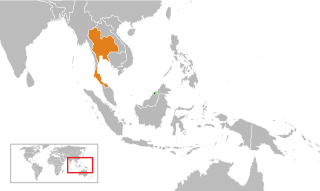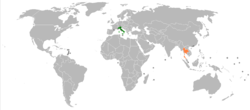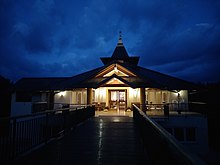
Chulalongkorn University, nicknamed Chula, is a public autonomous research university in Bangkok, Thailand. The university was originally founded during King Chulalongkorn's reign as a school for training royal pages and civil servants in 1899 at the Grand Palace. It was later established as a national university in 1917, making it the oldest institute of higher education in Thailand.

The Catholic Church in Thailand is part of the worldwide Catholic Church, under the spiritual leadership of the Pope in Rome.

Bilateral relations between the Kingdom of Thailand and the United States of America date back to 1818. Thailand and the United States have long been close allies and diplomatic partners.

Bilateral relations between Russia and Thailand date to the late nineteenth century, when the Russian Tsar Nicholas II and King Chulalongkorn of Siam formed a friendly personal relationship. The two countries exchanged legations in 1897–1898, and signed a declaration of friendship in 1899. Diplomatic relations were terminated following the Russian Revolution in 1917, and re-established between the Soviet Union and Thailand on 12 March 1941; Thailand recognized the Russian Federation as the successor to Soviet Union on 28 December 1991. Russia has an embassy in Bangkok and two honorary consulates in Phuket and Pattaya. Thailand has an embassy in Moscow and two honorary consulates. Both countries are full members of APEC and the Organization for Security and Co-operation in Europe.

Canada and Italy. Both nations enjoy friendly relations and are close allies and partners through their membership in the G7, G20, NATO and the Organisation for Economic Co-operation and Development. Relations also centre on the history of Italian migration to Canada; approximately 1.5 million Canadians claim to have Italian ancestry.

Denmark–Thailand relations date back to 1621. Denmark operates an embassy in Bangkok, along with a consulate in Phuket, although it used to have one in Pattaya. The Danish embassy in Bangkok also handles Danish relations with Cambodia, with the current Danish ambassador of Thailand also being the ambassador to Cambodia. Thailand itself operates an embassy in Copenhagen.

India–Thailand relations, also known as the Indo–Thai relations, are the bilateral relations between India and Thailand. Relations were established in 1947, soon after India gained independence. Priests have provided a cultural link between the two countries since 1500 BCE. India shares a long sea border with Thailand as India's Andaman and Nicobar Islands share a maritime border with Thailand along the Andaman Sea. Since 2001, both countries have witnessed growing warmth, increasing economic and commercial links, exchange of high-level visits, and the signing of various agreements leading to a further intensification of relations. Thailand and India are cooperating in various multilateral fora like India's dialogue partnership with ASEAN, the ASEAN Regional Forum (ARF), and the East Asia Summit, the sub-regional grouping BIMSTEC involving Bangladesh, India, Sri Lanka, Thailand, Myanmar, Nepal and Bhutan, and trilateral transport linkages with Thailand, Myanmar and India. India is a member of the Asia Cooperation Dialogue (ACD) initiated by Thailand in 2002 and of the Mekong–Ganga Cooperation (MGC), a group of six countries.

Yingluck Shinawatra is a Thai businesswoman, politician and a member of the Pheu Thai Party who became the 28th prime minister of Thailand following the 2011 election. Yingluck was Thailand's first female prime minister and its youngest in over 60 years. She was removed from office on 7 May 2014 by a Constitutional Court decision.

Filipino–Thai relations refers to the bilateral relations between the Philippines and Thailand. The Philippines established formal diplomatic relations with Thailand on June 14, 1949. The relations between the two are described as warm and friendly. Thailand is one of the Philippines' major trade partners and one of the Philippines' sources of rice through Thai exports. Bilateral relations continues to be strengthened through talks and agreements on economic, security and cultural matters including concerns on rice trade, fight on drugs and human trafficking. Thailand has an embassy in Manila and an honorary consulate in Cebu, while the Philippines maintains an embassy in Bangkok. Both countries are members of ASEAN and the Non-Aligned Movement.

Brunei and Thailand have bilateral foreign relations. Brunei has an embassy in Bangkok, and Thailand has an embassy in Bandar Seri Begawan. The relations have always been close and cordial.
The year 2014 was the 233rd year of the Rattanakosin Kingdom of Thailand. It was the 69th year in the reign of King Bhumibol Adulyadej, and is reckoned as year 2557 in the Buddhist Era. Significant events include the continuing political crisis which led to a coup d'état on 22 May.

The nations of Mexico and Thailand established diplomatic relations in 1975. Both nations are members of the Asia-Pacific Economic Cooperation, Forum of East Asia-Latin America Cooperation and the United Nations.

Iran–Thailand relations refer to the bilateral relations between Iran and Thailand. Iran has an embassy in Bangkok while Thailand has an embassy in Tehran.

Kosovo–Thailand relations are foreign relations between the Republic of Kosovo and the Kingdom of Thailand. Thailand recognised the Republic of Kosovo as independent state on 24 September 2013.

Relations between Portugal and Thailand date as far as the 16th century. Portugal was the first European nation to make contact with the Ayutthaya Kingdom, in 1511. The Portuguese became dominant foreign traders, and established a presence in the capital. Portuguese traders introduced firearms as well as New-World goods from the Columbian Exchange, influencing Thai cuisine, language and culture. Although Portugal's overseas influence gradually declined from the 17th century, it maintained ties with Siam. The Portuguese Embassy in Bangkok, established in 1820, is the oldest diplomatic mission in the country. In contrast to other European powers, against whose colonial aspirations Siam struggled during the 19th century, Siam's relationship with Portugal was largely friendly. Both countries elevated their missions to embassy status in 1964, and Thailand established a resident embassy in Lisbon in 1981. Today, the two countries share a small amount of trade, tourism and cultural activities.

Spain–Thailand relations are the bilateral and diplomatic relations between these two countries. Thailand has an embassy in Madrid and two honorary consulates in Barcelona and Santa Cruz de Tenerife. Spain has an embassy in Bangkok.

Thailand–Turkey relations are the modern foreign relations between Thailand and Turkey. The cordial relations between the two countries date back to 1958, when the two countries established diplomatic relations. Shortly after, Turkey set up its embassy in Bangkok. Thailand reciprocated by opening its embassy in 1972. However, even during the era of the Ottoman Empire, there had been historical contacts between the Empire and Siam at the time -- most notably the visit of Prince Damrong, younger brother of King Chulalongkorn the Great of Siam, to Istanbul as the royal guest of Sultan Abdul Hamid II in 1891.

Chadchart Sittipunt is a Thai politician, engineer, and professor who is the incumbent Governor of Bangkok. He previously was Minister of Transport from 2012 to 2014.

































